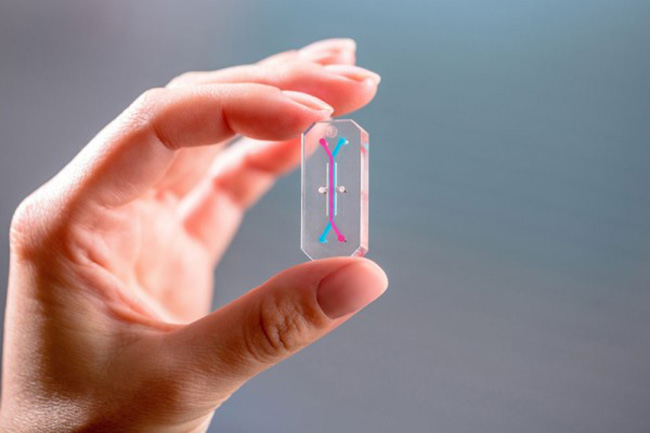
Food- and water-borne illness such as the 2016 campylobacteriosis outbreak in Havelock North cause a significant burden of illness in New Zealand. Organ-on-a-chip technology could help us understand why some bacteria causes disease and which are the strains to worry about.
Dr Jan Powell is a science leader in ESR’s Risk Assessment and Social Systems team. She’s spent the last year setting up organ-on-a-chip technology to find out if this clever cell culture system can help pinpoint which strains of Campylobacter are pathogenic. Here she explains more about the technology and her research.
What is organ on a chip?
It’s an in-vitro 3D cell culture system that mimics human organs. Imagine a plastic chip no bigger than an AA battery lined with living cells and matrix that can simulate the activities, mechanics and physiological response of an entire human organ or organ system. It can be used to find out how the human body reacts to hazards such as microorganisms, toxins and pharmaceuticals.
What’s it got to do with Havelock North?
More than 8,000 people got sick and four died as a result of Havelock North’s 2016 water contamination outbreak. Campylobacter jejuni was identified as the culprit, but there are lots of different strains of the bacteria and not all of them are pathogenic. We’re hoping that organ-on-a-chip technology will give us a non-animal model to interrogate and see if we can identify which strains are going to be pathogens and more likely to cause disease, as we saw in Havelock North.
Could identifying the ‘nastiest’ strains of bacteria better protect public health?
Maybe. In New Zealand most of the illness caused by Campylobacter comes from chicken. Understanding which strains go on to cause illness and which strains don’t could help the development of targeted food control strategies. Likewise, if we understand how Campylobacter interacts with human cells, then we may be able to develop additional strategies to prevent people from becoming ill, or develop better treatments.
What advantages does organ-on-a-chip technology have over other models?
Up until now, we’ve tended to use two-dimensional models (cells in a single layer) which can only show basic outcomes. Three-dimensional models like the organ-chip allow you to increase the complexity, so you can observe a three-dimensional cellular structure and you can put more than one cell type together. This allows the cells to behave in a more physiological way with the partners they would normally interact with.
Three-dimensional models also have an advantage over animal-models, which are becoming less acceptable to use, and where it is often difficult to replicate human infections.
Can organ-on-a-chip allow for physiological differences in humans?
Organ-on-a-chip uses human cells, but it’s an in-vitro model, so it comes with the caveats of a model that exists outside of a complicated human system. However, research groups around the world are already using primary cells from human tissues, which allows them to consider things like genetics, ethnicity and pre-existing health conditions akin to personalised medicine.
At ESR we’re using human cells, but we’re currently using immortalised (cancer) cell lines that are designed to grow over longer periods. In the future we hope to use ethically sourced and culturally-safe primary cells from different volunteers which will allow us to investigate physiological differences between humans and their response to particular hazards.
What’s stopping organ-on-a-chip being more widely adopted?
At present, it’s a lot more expensive than 2D cell culture, and you definitely have to think what your application is. For the sort of questions we want to answer about pathogens, science has moved beyond 2D cultures so we need a more sophisticated system.
Where else do you see the potential to use this technology?
The two main areas at the moment are bacterial pathogenesis, like our Campylobacter study, and toxicology/pharmacology, for example liver toxicity studies to explore the potential health effects from vaping chemicals and synthetic cannabis. The USFDA has recognised that organ chip technology is being developed to be integrated into regulatory toxicology assessments, so the technology is moving pretty fast.
What excites you the most about this technology?
I’m excited about having better physiologic models that we can use to find out how humans react to certain hazards such as microbes, toxins and pharmaceuticals. Anything that allows us to better understand and improve people’s health is huge, particularly if we can do it ethically, more accurately and without using animals.
ESR’s organ-on-a-chip system is supplied by Emulate. Emulate, Inc. is the leading provider of next-generation in vitro models and is igniting a new era in human health with industry-leading Organ-on-a-Chip technology. The Human Emulation System provides a window into the inner workings of human biology and disease, offering researchers an innovative technology designed to predict human response with greater precision and detail than conventional cell culture or animal-based experimental testing. Pioneered at the Wyss Institute for Biologically Inspired Engineering at Harvard University, Organ-on-a-Chip technology is assisting researchers across academia, pharma, and government industries through its predictive power and ability to recreate true-to-life human biology.